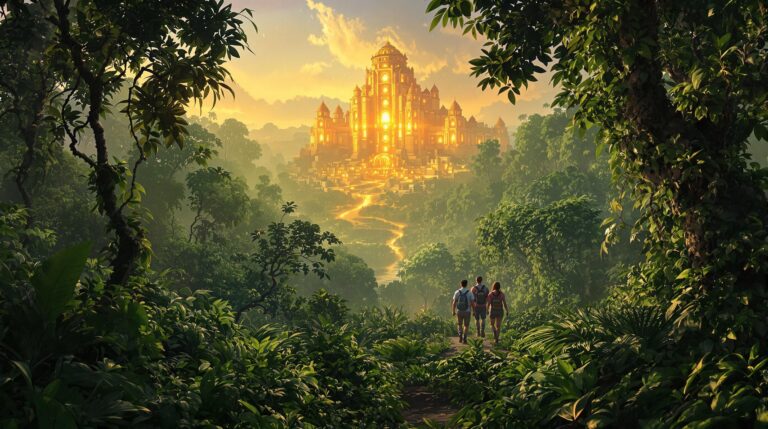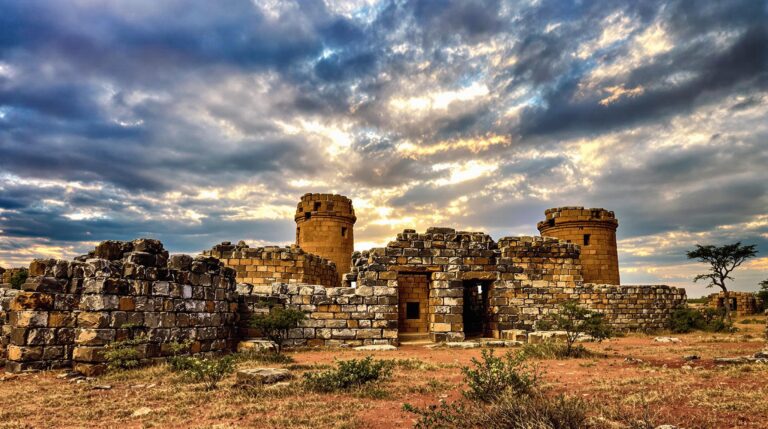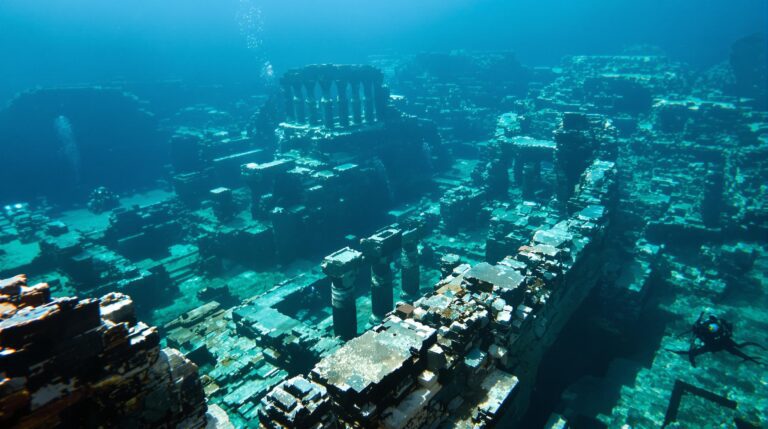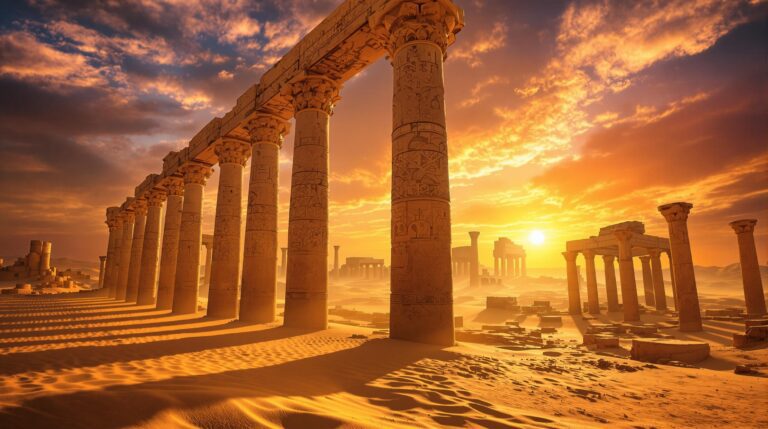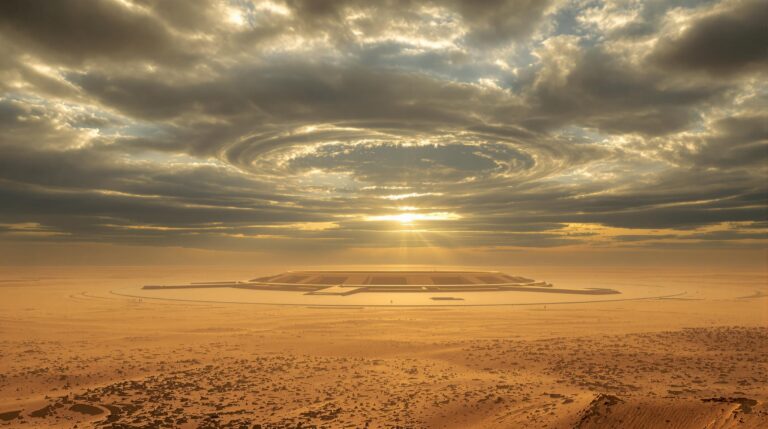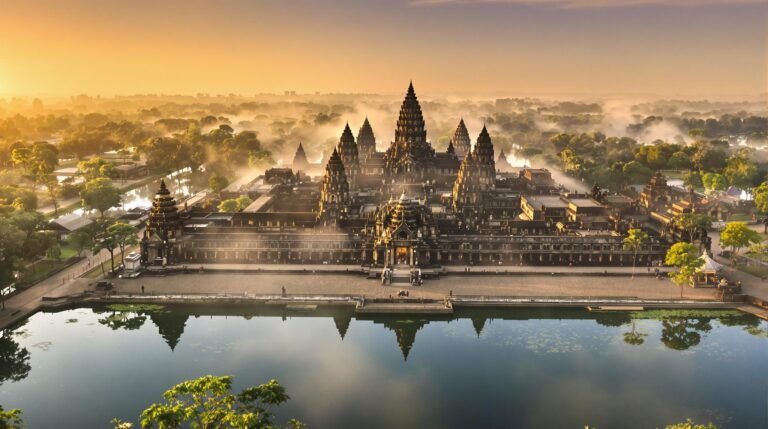Merv: Central Asia’s Forgotten Metropolis
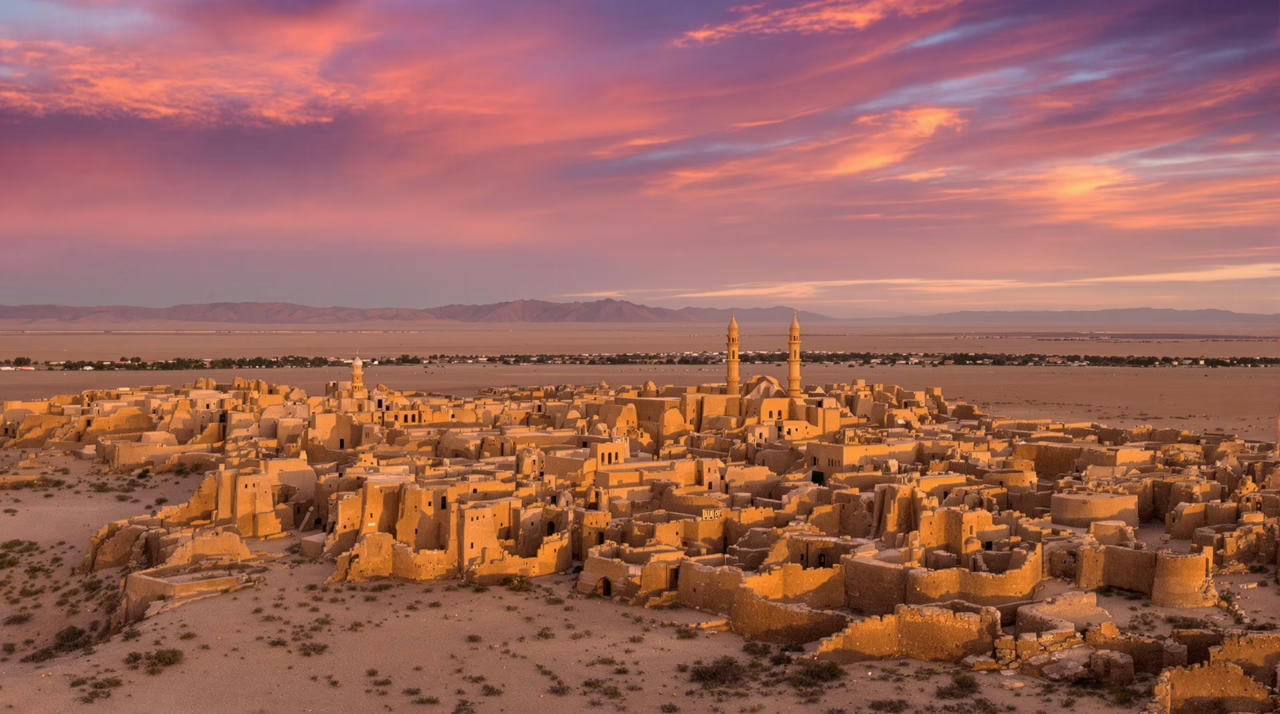
Merv, once a jewel of the Silk Road, whispers tales of grandeur and cultural fusion. Its streets, once alive with scholars and traders, now lie beneath the sands of time.
The legacy of the Achaemenids and Seljuk Turks intertwines with the scars left by the Mongol invasion. Yet, remnants of its brilliance beckon for attention.
What secrets lie buried in this forgotten metropolis, waiting to be uncovered and understood?
Key Takeaways
Hide- Merv was a crucial trade hub along the Silk Road, showcasing its historical significance in facilitating commerce and cultural exchange.
- The city experienced a golden age of Islamic scholarship, rivaling Baghdad's intellectual centers, fostering diverse philosophical dialogues among various religions.
- Architectural achievements, such as Qasr al-Kisra, highlight Merv's innovative design and advanced infrastructure, adapting to its arid climate.
- The Mongol invasion led to Merv's decline, transforming it from a vibrant metropolis into a haunting reminder of a lost civilization.
- Modern preservation efforts face challenges, yet Merv remains a symbol of Turkmenistan's heritage, influencing contemporary urban planning and regional identity.
Merv: A City at the Crossroads of Empires
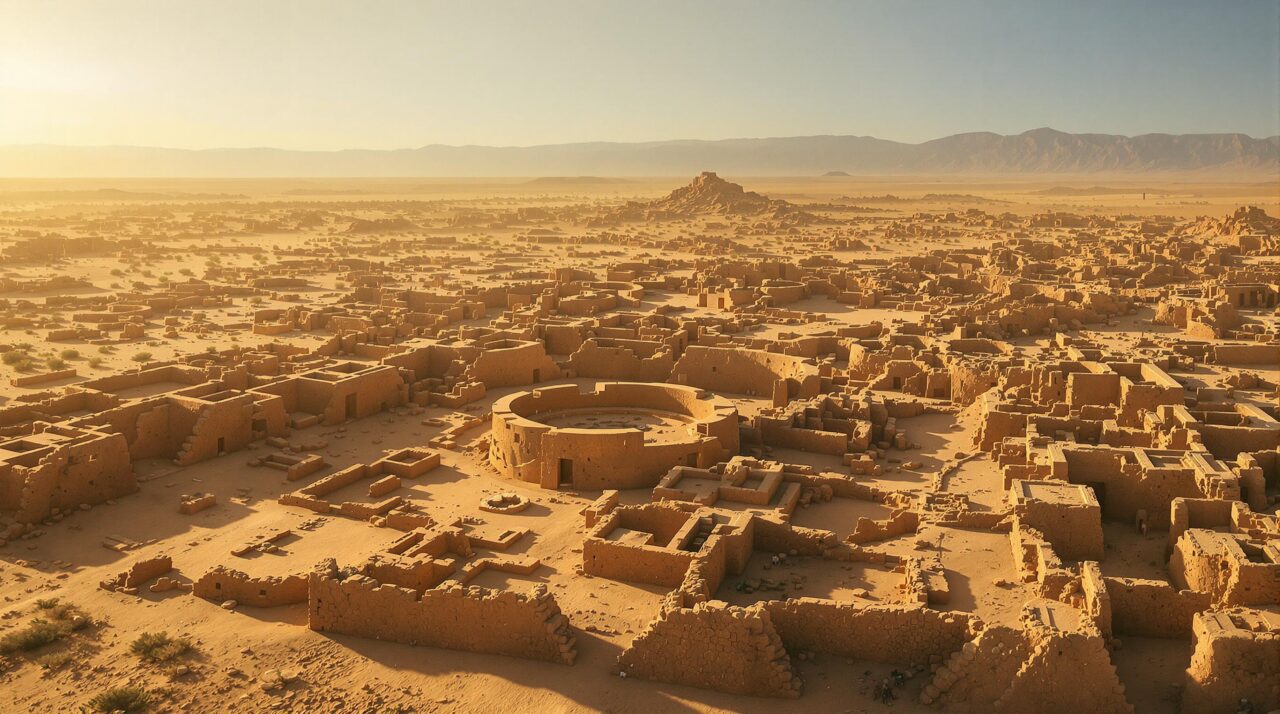
Merv, nestled along the ancient Silk Road, stood as a pivotal nexus where empires collided and transformed.
Its strategic position invited a succession of rulers, each leaving an indelible mark on the city’s cultural tapestry, as power shifted like the desert winds.
This lively metropolis, once a jewel of commerce and diplomacy, echoed with the whispers of ambition and conquest, forever altering the course of history in Central Asia.
Strategic Position on the Silk Road
Merv, perched at the intersection of ancient trade routes, served as a lively tapestry woven from the ambitions of empires and the dreams of merchants.
More than a mere trading hub, it was a crucible of cultures, ideas, and innovations, where the East met the West in a dance of commerce and conquest.
As caravans traversed its sun-baked paths, Merv emerged not just as a waypoint, but as a crucial artery fueling the pulse of civilization across centuries.
Why Merv Was More Than Just a Trading Hub
Situated at the crossroads of empires, Merv emerged as a colorful tapestry woven from the threads of diverse cultures and strategic ambitions.
Beyond its trading prowess, Merv was renowned for:
- Architectural marvels that whispered tales of innovation
- A melting pot of philosophies and religions
- Flourishing arts and sciences that transcended borders
- Agricultural advancements that nurtured prosperity
- Diplomatic negotiations that shaped regional power dynamics
Linking East and West Across Centuries
As the sun rose over the vast expanses of Central Asia, a city flourished where the Silk Road‘s arteries converged, weaving together the destinies of East and West.
Merv, a tapestry of cultures and ideas, thrived as empires clashed and mingled, embodying the spirit of trade, diplomacy, and innovation.
Its strategic position transformed it into a crucial nexus in history’s grand narrative.
Power Shifts and Changing Rulers
Merv, a stunning jewel nestled in the arid expanse of Central Asia, has long stood as a symbol of the relentless tides of power that swept through its streets.
From the ancient Achaemenids, whose grand visions birthed its initial splendor, to the Seljuks, who transformed its skyline with architectural marvels, each conqueror left indelible marks on the city’s urban landscape.
This constant flux not only reshaped Merv’s physical form but also redefined its cultural essence, making it a fascinating reflection of the empires that vied for dominance along the storied Silk Road.
From Achaemenids to Seljuks and Beyond
Emerging from the shadows of history, Merv stands as a tribute to the relentless tides of empires that have risen and fallen across its storied expanse.
- Achaemenid foundations laid the groundwork for prosperity.
- The Silk Road flourished under Parthian rule.
- Sassanian influences enriched culture and architecture.
- Seljuk Turks expanded its significance as a hub.
- Mongol invasions marked a tumultuous transformation.
Impact of Conquest on Urban Development
The relentless march of empires through Merv’s storied landscape has left indelible marks on its urban tapestry, sculpting a city that reflects the dynamic interplay of power, culture, and architecture.
Each conqueror brought new designs and ideas, transforming Merv into a colorful mosaic.
This fluid evolution highlights the city’s resilience, where each shift in dominion carved deeper layers of identity, echoing the enduring spirit of its people.
Golden Age of Learning and Innovation
In the heart of Merv, a lively tapestry of knowledge and creativity unfolded during its Golden Age, where scholars gathered to exchange ideas that transcended borders.
Architectural marvels rose against the skyline, reflecting the ingenuity of urban planning that harmonized beauty with functionality.
This era not only fostered Islamic scholarship but also ignited a spirit of innovation that would echo through the annals of history, marking Merv as a beacon of enlightenment in a world often shrouded in darkness.
Merv as a Center of Islamic Scholarship
In the heart of Merv, where the whispers of scholars once danced through grand libraries, an intellectual renaissance flourished, igniting the minds of scientists and philosophers.
This lively center of Islamic scholarship, particularly during Al-Mamun’s era, served as a beacon of knowledge, rivaling the famed House of Wisdom in Baghdad.
The legacy of this golden age endures, echoing through the ages as a tribute to human curiosity and innovation.
Libraries, Scientists, and Philosophers
Amidst the sprawling sands of Central Asia, Merv flourished as a beacon of intellectual pursuit during the Golden Age of Islamic scholarship.
Its lively libraries housed:
- Ancient manuscripts and texts
- Pioneering scientists probing the cosmos
- Philosophers contemplating existence
- Teachers nurturing inquisitive minds
- Innovators shaping mathematics and medicine
This confluence of knowledge illuminated the path for generations, heralding a legacy of enlightenment.
Legacy of Al-Mamun’s Era and the House of Wisdom
As the sun set over the arid expanse of Central Asia, Merv stood as a tribute to the transformative influence of Al-Mamun’s era and the esteemed House of Wisdom.
This lively city flourished as a nexus of intellect, where scholars engaged in spirited discourse, and ideas transcended borders.
Merv’s legacy, a beacon of enlightenment, continues to inspire those who seek knowledge and freedom in an ever-changing world.
Architectural Achievements and Urban Planning
In the heart of Merv, the grandeur of Qasr al-Kisra rises, a symbol of the city’s architectural prowess during its golden age.
Surrounded by formidable city walls and adorned with intricate mosques, the metropolis showcases a masterful blend of design and functionality that served its thriving populace.
Each structure, from public infrastructure to sacred spaces, narrates a story of innovation and cultural exchange, illuminating Merv’s legacy as a beacon of civilization in Central Asia.
Qasr al-Kisra and the Grand Structures of Merv
The grandeur of Qasr al-Kisra, an emblematic structure within Merv, reflects the city’s pivotal role during its Golden Age, where architectural innovation and urban planning flourished.
Key features of this remarkable era include:
- Intricate brickwork and mosaics
- Advanced water management systems
- Expansive public spaces for social interaction
- Strategic urban layouts enhancing trade
- Harmonious blending of diverse cultural influences
These elements embody Merv’s architectural legacy.
City Walls, Mosques, and Public Infrastructure
While the sun cast golden rays over Merv, the city’s formidable walls stood as silent sentinels, encapsulating a lively world of learning and innovation.
Majestic mosques adorned the skyline, their intricate designs echoing the spiritual fervor of the era.
Advanced public infrastructure intertwined with residential quarters, fostering a dynamic exchange of ideas, ensuring that Merv thrived as a beacon of cultural and intellectual freedom.
The Mongol Invasion and Aftermath
The Mongol invasion swept through Merv like a dark tide, engulfing a civilization that had once flourished as a beacon of culture and knowledge.
As the city’s grand structures crumbled under the relentless siege, the echoes of its lively past faded into silence, leaving behind a haunting reminder of what was lost.
The aftermath, marked by desolation and despair, sealed Merv’s fate, transforming it from a thriving metropolis into a ghostly relic of history.
The Siege That Ended a Civilization
In the shadow of Genghis Khan’s relentless onslaught, Merv transformed from a thriving bastion of culture into a haunting tableau of desolation.
The streets, once bustling with life, echoed only with the whispers of survivors, their tales woven with threads of tragedy and loss as they fled the carnage.
As the dust settled, the skeletal remains of this once-great civilization stood as a stark reminder of the massacre that extinguished its brilliance and left only refugees in its wake.
Genghis Khan’s Assault and the Massacre
Merv, once a flourishing center of culture and trade, faced annihilation as Genghis Khan released his brutal campaign across Central Asia.
The city succumbed to devastation, with:
- Unrelenting siege tactics
- Widespread civilian massacres
- Destruction of architectural marvels
- Plundering of wealth and resources
- The erasure of a lively civilization
In this dark chapter, Merv’s legacy faded, lost in the echoes of time and terror.
Survivors, Refugees, and Abandoned Streets
Amidst the ruins of Merv, echoes of despair lingered long after the Mongol forces had departed, leaving a city marked by both tragedy and resilience.
Survivors wandered through abandoned streets, their whispers of lost grandeur mingling with the dust.
Refugees sought solace in the remnants, memories etched in crumbling walls, as hope flickered amidst the shadows—a reflection of the indomitable spirit of humanity.
Why Merv Never Recovered
In the wake of the Mongol invasion, Merv’s once-thriving trade routes lay in ruins, severing the lifeblood that connected it to the broader world.
As power shifted to new centers, the echoes of its past grandeur faded, leaving the city to grapple with a changing climate that further eroded its resources.
The combination of these relentless forces rendered Merv not just a memory, but a haunting reminder of a civilization that could not withstand the tide of history.
Collapse of Trade Routes
The Mongol invasion of the 13th century marked a seismic shift in the landscape of Central Asian trade, and Merv, once a thriving hub, became a poignant symbol of this transformation.
The collapse of trade routes resulted in:
- Disruption of caravan networks
- Economic decline
- Loss of cultural exchanges
- Population displacement
- Erosion of local governance
Merv’s once-bustling streets fell silent, echoing the fate of a forgotten metropolis.
Shifts in Power and Climate Factors
Although Merv had long stood as a beacon of prosperity in Central Asia, the aftermath of the Mongol invasion precipitated a dramatic realignment of power dynamics and environmental conditions that hindered its recovery.
The relentless march of the conquerors left devastation in their wake, while shifting climate patterns turned fertile lands into arid wastelands, sealing Merv’s fate as a relic of its former glory.
Layers of Civilization Beneath the Sand
Beneath the shifting sands of Merv lies a tapestry of civilizations, each layer whispering stories of grandeur and decline.
Archaeologists face intimidating challenges as they endeavor to unearth these remnants, steering through political complexities and the delicate balance of preservation.
Every excavation reveals not just artifacts, but the echoes of a lively past that still yearns for recognition.
Excavation of Ancient Eras
Beneath the arid embrace of Merv’s sands lie the remnants of its storied past, with Erk Kala, Gyaur Kala, and Sultan Kala revealing layers of civilization like the pages of an ancient manuscript.
Each excavation unearths a treasure trove of tools, coins, and ceramics, whispering tales of the myriad cultures that once thrived in this forgotten metropolis.
As archaeologists sift through these artifacts, they piece together a colorful tapestry of human endeavor that spans centuries, inviting a deeper understanding of this historical jewel.
Erk Kala, Gyaur Kala, Sultan Kala: A City in Layers
As the sun casts long shadows over the arid landscape of Merv, layers of civilization lie hidden beneath the sands, waiting to reveal their secrets.
- Erk Kala’s formidable walls whisper tales of defense.
- Gyaur Kala, a religious hub, beckons with echoes of devotion.
- Sultan Kala boasts architectural grandeur.
- Ancient trade routes entwine the cities.
- Each layer offers a glimpse into humanity’s relentless quest for survival.
Tools, Coins, and Ceramics from Multiple Periods
Excavations at Merv have unearthed a trove of artifacts, each telling a story of its own within the tapestry of the city’s history.
Ancient tools reveal the craftsmanship of bygone eras, while coins whisper tales of trade and cultural exchange.
Ceramics, adorned with intricate designs, reflect the aesthetic ideals of their time, illuminating the diverse civilizations that flourished beneath the sands.
Preservation Efforts and Archaeological Hurdles
As the sun scorches the remnants of Merv, the challenge of restoring this once-thriving metropolis looms larger than the arid dunes that encase its treasures.
Each layer of civilization, buried beneath the sand, presents both a historical narrative and an urgent call for international collaboration to safeguard its legacy.
Without concerted efforts, the whispers of ancient voices risk fading into silence, lost forever beneath the relentless desert winds.
Challenges of Restoring a Desert City
Beneath the shifting sands of Merv lies a complex tapestry of civilizations, each layer whispering stories of prosperity and decline.
Restoring this desert city presents numerous challenges, including:
- Erosion and weathering of structures
- Limited funding for preservation projects
- Political instability affecting archaeological efforts
- Insufficient local expertise in conservation
- Balancing tourism with preservation needs
These hurdles threaten to obscure Merv’s rich historical narrative.
Importance of International Collaboration
While the sands of Merv cradle the remnants of ancient empires, the task of preserving its layered history demands a concerted effort that transcends national borders.
International collaboration among archaeologists, historians, and conservationists fosters innovative methodologies and resource sharing.
This collective endeavor not only safeguards Merv’s invaluable artifacts but also ignites a global appreciation for cultural heritage, urging humanity toward a shared future.
Religious Harmony and Cultural Exchange
In the arid embrace of Central Asia, Merv emerged as a lively tapestry woven from the threads of diverse cultures and beliefs.
Here, caravans laden with spices and silks crossed paths, fostering a rich exchange of ideas that transcended religious boundaries. The city became a sanctuary where faiths intertwined, creating a unique harmony that resonated through its bustling markets and sacred spaces.
Diversity in the Heart of the Desert
In the arid embrace of the desert, Merv stands as a symbol of the colorful mosaic of human belief, where Zoroastrians, Christians, Buddhists, and Muslims once coexisted in a harmonious ballet of faith.
This unique convergence not only fostered a spirit of tolerance but also ignited a lively exchange of art and language, shaping a cultural legacy that continues to echo through time.
As the sands shift, the stories of these diverse communities linger, inviting exploration into the intricate connections that define a forgotten metropolis.
Zoroastrians, Christians, Buddhists, and Muslims
Merv, a historical crossroads in Central Asia, stands as a demonstration of the diverse fabric of religious harmony and cultural exchange that once flourished in its arid landscapes.
Here, four faiths intertwined, cultivating a colorful mosaic:
- Zoroastrian fire temples
- Christian monasteries
- Buddhist stupas
- Islamic mosques
- Shared philosophical dialogues
Each belief system contributed to Merv’s legacy, fostering an environment of mutual respect and understanding amidst the desert’s expanse.
Influence of Tolerance on Art and Language
Tolerance, as a guiding principle, sculpted the artistic and linguistic landscape of this ancient metropolis.
In Merv, lively mosaics intertwined with calligraphic scripts, echoing the harmonious coexistence of diverse cultures. This religious harmony fostered a diverse fabric of expression, where poets and artisans drew inspiration from one another’s beliefs.
Consequently, language flourished, evolving into a medium that celebrated unity amidst diversity, enchanting hearts across generations.
Cross-Cultural Trade and Ideas
In the bustling heart of Merv, the echoes of distant lands reverberated through its marketplaces, where the lively colors of Chinese porcelain and the shimmering allure of Roman glass spoke of an intricate web of trade.
This ancient metropolis served not merely as a conduit for goods, but as a fertile ground for the exchange of ideas and beliefs, fostering a unique tapestry of religious harmony.
Amid the mingling of cultures, Merv stood as a tribute to the power of connection, where every artifact told a story of shared humanity across vast horizons.
Exchange of Goods and Knowledge with Distant Regions
Nestled along the ancient Silk Road, Merv emerged as a lively hub where the exchange of goods and knowledge transcended borders, weaving together a colorful fabric of cultural and religious diversity.
Here, merchants and scholars shared:
- Textiles from Persia
- Spices from India
- Scientific manuscripts
- Philosophical ideas
- Artistic traditions
This dynamic interplay fostered a unique atmosphere of harmony and enlightenment, shaping Merv’s legacy as a beacon of intercultural dialogue.
Traces of Chinese Porcelain and Roman Glass
Amid the lively exchanges of the Silk Road, Merv stood as a proof of the profound impact of cross-cultural trade, evidenced by the remnants of Chinese porcelain and Roman glass that have surfaced in its archaeological sites.
These artifacts whisper tales of merchants traversing vast landscapes, intertwining cultures, and sharing ideas, each shard embodying a moment where artistic expression transcended boundaries, fostering a unique tapestry of religious harmony and cultural exchange.
Why Merv Still Matters
Merv, once a beacon of pre-modern urban sophistication, offers a compelling lens through which to understand the intricate tapestry of Central Asian identity.
Its ruins whisper tales of cultural confluence and resilience, reminding contemporary societies of their shared heritage.
In an age of globalization, the lessons gleaned from Merv’s storied past resonate with urgent relevance, urging a reflection on the roots of regional identity.
Insights into Pre-Modern Urban Complexity
Merv stands as a testament to pre-modern ingenuity, where intricate infrastructure and astute water management transformed a harsh landscape into a thriving oasis.
Its city planning, resilient enough to endure the passage of centuries, reveals a sophistication that continues to inspire contemporary urban thought.
In examining Merv’s historical complexity, one uncovers invaluable lessons that resonate far beyond its ancient walls.
Lessons from Infrastructure and Water Management
While ancient empires often captured the limelight, the city of Merv offers profound insights into the intricate tapestry of pre-modern urban complexity, particularly in its innovative approaches to infrastructure and water management.
Key lessons include:
- Advanced irrigation systems utilizing rivers
- Strategic placement of reservoirs
- Sustainable urban drainage techniques
- Community engagement in maintenance
- Adaptation to the arid climate
These elements reveal Merv’s enduring relevance.
City Planning That Withstood Centuries of Use
Although centuries have passed since its zenith, the city of Merv stands as a tribute to the ingenuity of pre-modern urban planning, where meticulous design intersected with the harsh realities of the Central Asian landscape.
Its labyrinthine streets, fortified walls, and waterworks reflect an understanding of sustainability, showcasing how ancient civilizations harmonized human ambition with nature’s challenges, creating a resilient urban tapestry.
Modern Relevance in Regional Identity
Merv stands as a poignant symbol of Turkmenistan’s national heritage, where the echoes of its Silk Road glory intertwine with the shadows of its decline.
This ancient metropolis, once a lively hub of commerce and culture, continues to shape the regional identity, embodying the resilience and richness of Central Asian history.
As modern Turkmen society grapples with its past, Merv’s legacy serves as both a reminder of triumph and a cautionary tale of impermanence.
Merv’s Legacy in Turkmenistan’s National Heritage
Often overshadowed by more prominent cities, Merv remains a cornerstone of Turkmenistan’s national identity, echoing the grandeur of its ancient past.
Its legacy manifests through:
- Rich architectural heritage
- Symbolic connections to Turkmen culture
- Historical narratives of resilience
- Influence on regional identity
- Preservation efforts for future generations
Merv’s enduring spirit inspires a collective memory, reminding Turkmenistan of its storied journey through time.
A Symbol of Silk Road Brilliance and Collapse
Nestled within the arid expanse of Central Asia, Merv stands as a poignant symbol of the duality of prosperity and decline experienced along the ancient Silk Road.
Once a flourishing nexus of trade and culture, its ruins echo tales of resilience and loss.
Today, Merv’s remnants serve as a powerful reminder of regional identity, inspiring a longing for connection amidst the echoes of history.
Wrapping Up
In the shadow of crumbling minarets and the whisper of ancient winds, Merv’s legacy persists like a ghostly echo, reminding the world of its once-vibrant tapestry of cultures.
Coincidentally, as modern cities grapple with division, Merv stands as a beacon of unity and exchange.
Its layered history, buried yet resilient, beckons explorers to unearth not just relics but the enduring spirit of collaboration.
Merv may be forgotten, but its lessons of harmony and innovation resonate louder than ever.
